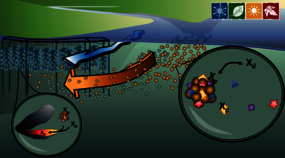Reactivity and bioaccumulation of rare earth elements and metalloids in contrasting hydrological systems: searching for elemental traits and understanding system behaviour
The European Union has identified, among many elements, the rare earth elements (REEs), and several metalloids (i.e., arsenic - As, antimony - Sb, selenium - Se, tellurium - Te, and germanium - Ge) as strategic / critical raw materials, necessary for the future development of technologies in modern societies. However, despite their emerging use and on-going studies in environmental compartments, there are still several knowledge gaps regarding their transport, reactivity, and fate in aquatic systems.
This study presents a compilation of REE and metalloid concentrations in several samples (water, suspended sediments and mussel tissues) collected in different hydrological systems of Germany (i.e., focused on the Rhine, Neckar and Danube rivers). Water samples were collected at a monthly frequency for one year, accounting for potential colloidal influence via comparison of mesh size filtration (0.02 µm vs 0.45 µm). Annual samples of suspended sediments and mussel aliquots for the last 5 years were provided for the Rhine and Danube rivers by the national bank of environmental samples. Sediment samples were leached with selective extraction protocols to account for elemental mobility vs major solid carrier phases and were also digested fully to provide the information on the total element concentration in the solid phase. Mussel samples were fully digested via aqua regia. Trace element analyses were performed via external calibration at the ICP-MS (RQ iCAP Thermo®).
Preliminary results are very contrasting among elements and rivers, suggesting that element reactivity and transport are not element dependent (dominated by common geochemical properties) but river dependent, according to the system hydro sedimentary characteristics and traits. For example, REEs and metalloid transport and reactivity in the Danube River seem to be dominated by bio/hydro/geological processes including organic matter degradation and adsorption. Meanwhile, trace element dynamics in the Neckar River is forced by the anthropogenic influence (industrial activities downstream) and potential kinetic effects (delayed sorption). Contrastingly, the upper Rhine River shows no differences in elemental concentrations between upstream and downstream sampling sites, despite the presence of different solid phases responsible for the metalloid mobility, i.e., Sb being the most mobile metalloid (i.e., lowest Kd, associated with several phases), followed by As (mainly liked to amorphous iron oxides), Se and Te (mostly found in the acid soluble fraction) and Ge (barely mobilized from the solid phase). These observations suggest a relatively controlled system in the Rhine River, with either little variations along the year or diverted processes (e.g., taking place on the riverbanks). However, elemental bioaccumulation seems to be related to the element load in each river, accumulating more elements (e.g., As, Se and REEs except La) in the Danube River than in the Rhine, with a non-negligible influence from the trophic pathway as the main intake source.
All these results contribute to a better understanding of the biogeochemical cycles of metalloids and REEs in aquatic systems. They also show that: (i) mussels are sensitive bioindicators of increased levels in rivers systems, but (ii) potential increases in elemental concentrations due to releases from technological advancements will have different geochemical signals and fate, specific to the river, and (ii) future geochemical predictions of elemental behaviour cannot be not foreseen without a better characterization and understanding of the impacted system.

